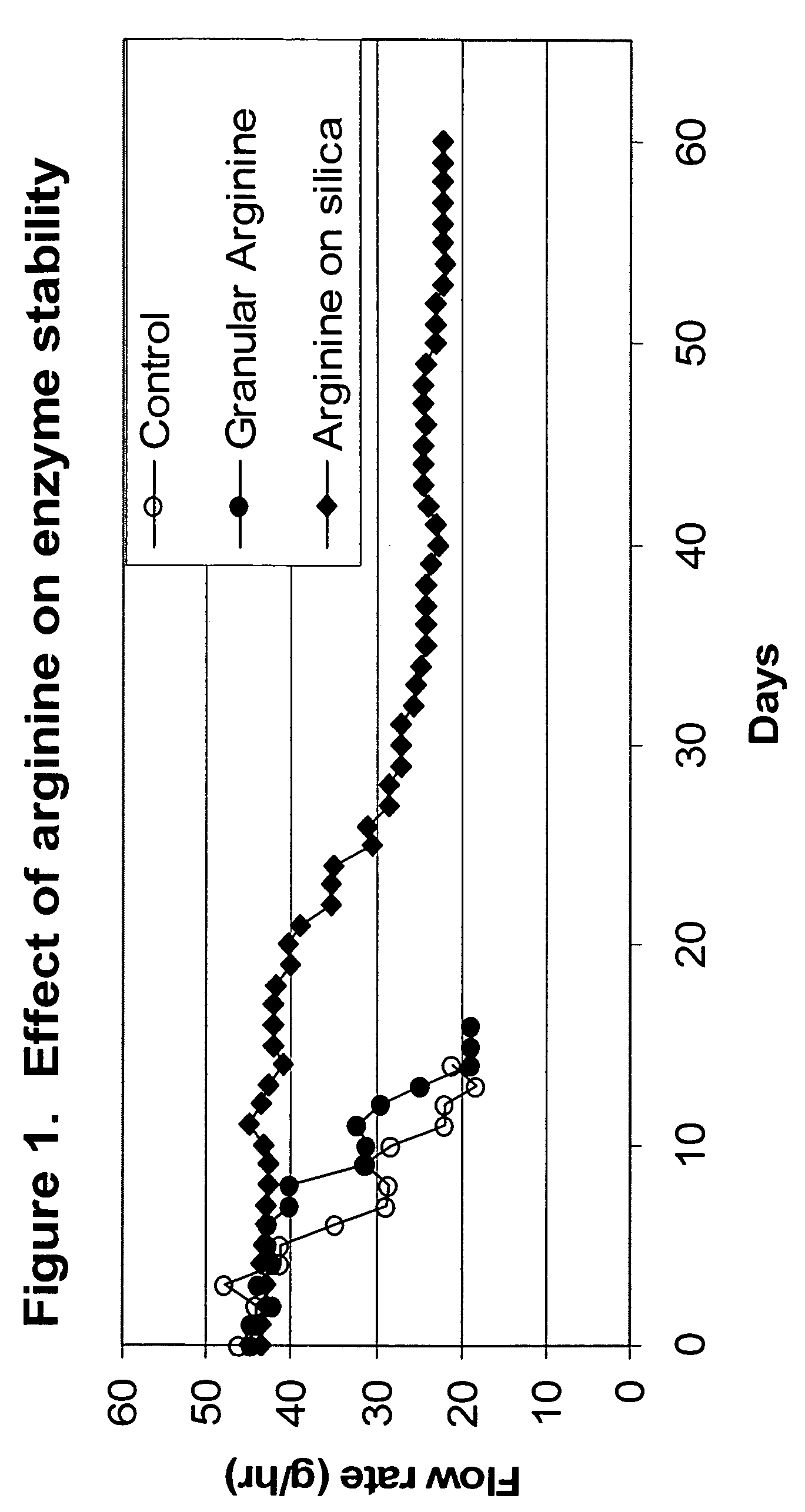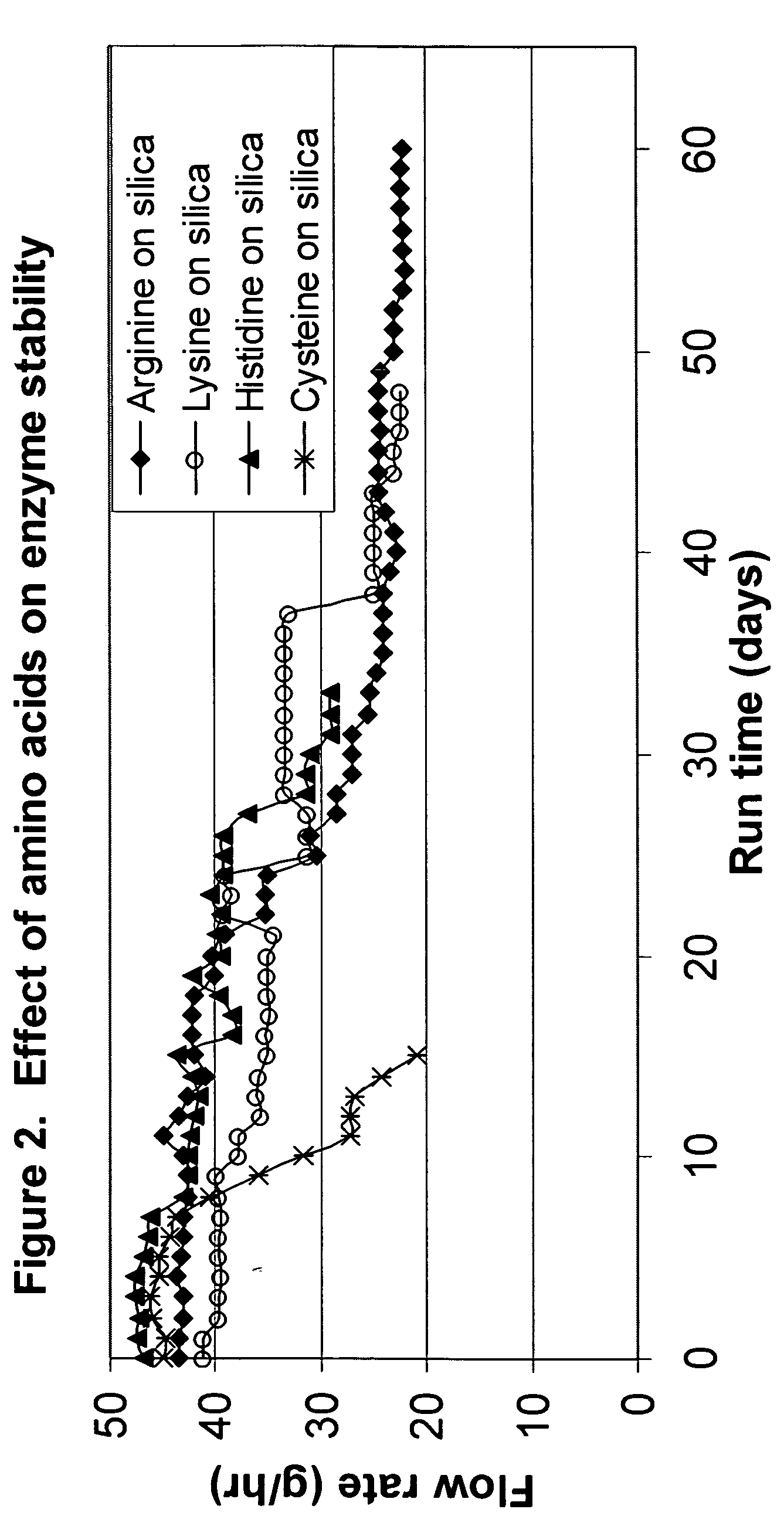Method for producing fats or oils
a technology of fats and oils, applied in the direction of fatty substance production, fatty-oil/fat refining, fermentation, etc., can solve the problems of enzyme degradation, minor components of oil can have cumulative deleterious effects on enzyme activity, and the effective life of the catalyst is reduced
- Summary
- Abstract
- Description
- Claims
- Application Information
AI Technical Summary
Benefits of technology
Problems solved by technology
Method used
Image
Examples
example 1
[0133] The following example shows the effect of arginine pretreatment of the substrate on lipase half-life. The following three experiments were performed in this example: i) the activity of lipase was monitored upon exposure to substrate which had undergone no arginine pre-treatment (“control”); ii) the activity of lipase was monitored upon exposure to substrate which was pretreated with granular arginine; and iii) the activity of lipase was monitored upon exposure to substrate which was pretreated with arginine-coated silica.
[0134] 9.4 g of enzyme (TL IM from Novozymes A / S, Denmark) was packed in a 1.5-cm diameter jacketed column (30 cm long) at a height of 11.8 cm, which gave 20.8 ml enzyme bed volume. The water circulating through the column jacket was held at 70° C. The piston pump and feed lines were wrapped with heating tape and covered with insulation to prevent any solidification of substrate.
[0135] The pre-treatment materials (i.e., purification media) were tested as oi...
example 2
[0141] Other amino acids were tested for their ability to increase the half-life of lipase. Preparations of the amino acid coated silica and conditions for column operation were the same as described in Example 1. The extent of enzyme reaction was monitored by the change of melting properties of the substrate and products, measured by Mettler Drop Point (MDP) as disclosed in U.S. Application Publication No. 2003 / 0054509 A1. The substrate blend was pumped to the column at a rate which gave the desired Mettler Drop Point (105-107° F.) of product oil exiting the lipase column, and the pumping rate was adjusted during tests to compensate for loss of lipase activity.
[0142]FIG. 2 shows the adjustment of the pumping rates for substrate treated with arginine-coated silica (closed diamonds), lysine-coated silica (open circles), histidine-coated silica (closed triangles), and cysteine-coated silica (stars “*”). The data of FIG. 2 is summarized in Table 2.
TABLE 2Pretreatment Effect of Argin...
example 3
[0144] 9.4 g of enzyme (TL IM from Novozymes) was packed in a 1.5 cm diameter jacketed column (30 cm long) at a height of 11.8 cm, which gave 20.8 ml enzyme bed volume. The water circulating through the column jacket was held at 70° C. A substrate blend of soybean oil and fully hydrogenated soybean oil (80 / 20 by weight) was prepared and introduced to the top of the column using an HPLC pump to feed substrate. The HPLC pump and feed lines were wrapped with heating tape and covered with insulation to prevent any solidification of substrate. The extent of enzyme reaction was monitored by the change of melting properties of the substrate and products, measured as Mettler Drop Point (MDP) as disclosed in U.S. Application Publ. No. 2003 / 0054509 A1. The substrate blend was pumped to the column at a rate which gave the desired Mettler Drop Point (105-107° F.) of oil exiting the column, and the pumping rate was adjusted during tests to compensate for loss of lipase activity.
[0145] Substrate...
PUM
 Login to View More
Login to View More Abstract
Description
Claims
Application Information
 Login to View More
Login to View More - R&D
- Intellectual Property
- Life Sciences
- Materials
- Tech Scout
- Unparalleled Data Quality
- Higher Quality Content
- 60% Fewer Hallucinations
Browse by: Latest US Patents, China's latest patents, Technical Efficacy Thesaurus, Application Domain, Technology Topic, Popular Technical Reports.
© 2025 PatSnap. All rights reserved.Legal|Privacy policy|Modern Slavery Act Transparency Statement|Sitemap|About US| Contact US: help@patsnap.com



